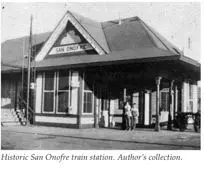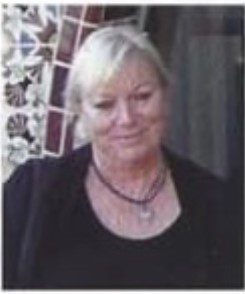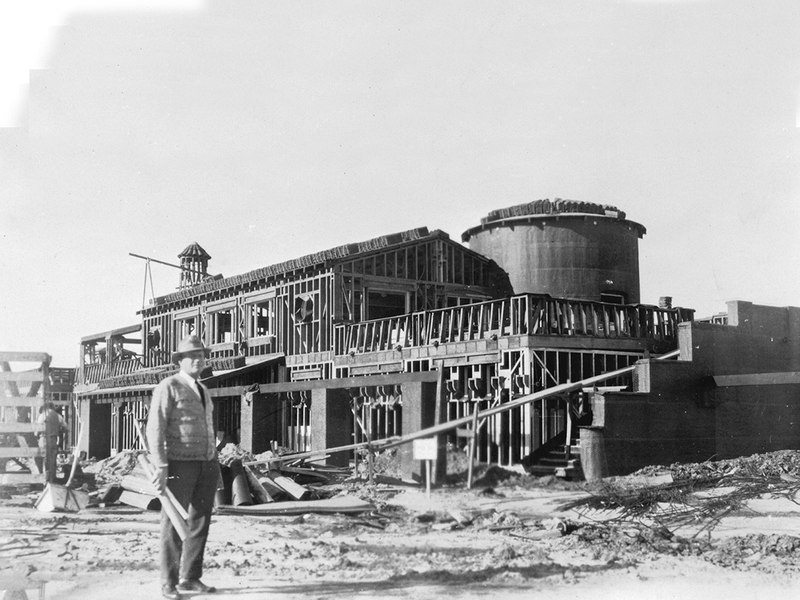San Onofre More than just a Surf Beach
By Christine Lampert, Architect, AIA, NCARB | Artwork by David Harris Lang
San Ouafie State Beach was mand in 1971 with the help of President Ricdund Noon. The park a just over 2.000 actes with five and a half miles of coat line.
The property is leand from the Depart man of the Navy and cumendy the 50-year lease is being megotiated. There an over 2 ndlion visius a year and is one of the meet visited state, parks in California.
The San Onufre Surf Beech is the mom popular surfing boak in all of the Unard Sou
Long before the mate pack eximed, the area called San Onofre had an interesting himury. It included the town of San Onofie nor where
Noon, beer malling at Camoni Point, Arged in San P
the surf beach ic today From about 1910 to 1960 driving along Highway Oenan Diego County you world have passed the small town of San Onob

An 1940’s map litt the arms at Rancho de San Ondri. No one is at who named this anburit was peably named by the Spanis afier an Egyptian monk who lived in the desest thewalermit
The Sun Mann warned provided water w the sanch cattle and the vaquero camp thar wat them for many years. In the 1870 John Former owned the ranch and be sold portion of the tinchland.
He also built the town of Former City on the blaffs above the mean. The 1880 cenam showed 165 peuple including farmen, sherp taisers and stock miatt living them. Then wu a stage depen, blacksmith dup, lisery stable, a hotel and a une room school house. Unfortunately, when Fuser died in 1862 he own dwindled dows to nothing
Richard O’Neill took over managing the ranchland and in 1888.
When the tailroad line was put in a train depet was built a San Onodir. las purpose was to mampon camle, ocher livestock and crops. The arms hecame very popular with canle enem including moros, und cattle buyers came from all over the southwest.
Finally with the 1910 cenas, die popula tion of San Cache was mentioned and the town was marting to ulin shape. The arva began attracting farmers who grow grew iwlery, leman, can taloupe, tomatoes, sagar larts, lana bene and flower
ArchihaM Maren arned from Michigan in 1925 with the Haven family send company. The Haven family invested in the Sen Ont economy and brought much suis to the And Haven lessed over 1,400 acres sar the main up and the settlement around the rais mation contined to grow inte the small town of San Onole.
A purel highway was built in 1929 which helped
the co suunay grow even mors with the building of a post office, a cafe, a service, and a grade school. Local fuhermen opened a mathet by the beach where the surfing Beach in today. A aufing chih war formand hathrooms weer hailt and 25 com wa charged se enter the beach. Many of south em Californian surfing legend las ar the bench incdaling the actos, James Amen.

Surfien had ducovered San Onofre beaches and beginning in the 1920s south ers Califumia might have bad ansund 75 mgalar surfers who had made sheir mes bounds and would drive up and down the all count highway snapping at San Onofie
In the 1940s when World War II hegan, the Santa Margarita Ranch prop erty was taken by enunent domain and be came Camp Pendleton Marine Base. The naf beach was very empty during the war
youm. Many of the surfers ined the m try fight the wat Givilians weren’t allowed surf then, but somehow locals managed in sneak on the beach to surf even though ther were daily beach wees by the military police. During the war youis wah gas ranoning and a shortage of supplies to make surfboanda, San Onofre rurfing almon emindy crand
With World War I, when the land wa taken over by the slitary, the farming tans on the land began in out. Many of the fam es living in San Onofre wete farm Japanese descen. During the war, these fami жете по дебит cangs henne of ther Jepantse heritage even though their familias had inmignated in the USA and we do longer lapunere. This was one of the biggen in outs of the wat.

After the war surfing began to mun San Onofin. Een though the bosch was mill meil, the commandag officers quietly al lowed nirfers mum. Many of them were World War II veeram. Sinly the ald-time safers from the 1930s begin to ren to the beach
Around 1950 a lonsegned between the military and the surfen to allow fer the Sun Onofre Surfing Club to have a aw the beach, but soon everyone was showing up and the agerment wasn’t working, so tighet syarm was developed in 1952. Gam gandi wers hond and to ser one needed a window decal and membership ID.
The military maintained the entire arta until 1971, allowing the surf chil, unill San Onofre State Park was created in 1971 with a 50 yoso The pool few years ago but has been extended while a new least is
being onegotiated

It is easy to see that parts of Corsica looks look a lot like the hills of San Clemente before the town was built in the 1920s. The big difference is the architecture. Corsica has many small villages that were built hundreds of years ago mostly out of stone. However, red tile roofs are very common, just like San Clemente. Many of the newer structures in Corsica are stucco and resemble the San. Clemente style of architecture.
It is easy to understand how these two locations have a lot in common and both places are close to being paradise.

Christine Lampert of Lampert Dias Architects is a member of the American Institute of Architects and is certified with the National Council of Architectural Registration Boards. She has lived in San Clemente for more than 45 years, and used to reside part time in Hong Kong.
Christine Lampert, Architect, AIA, NCARB
